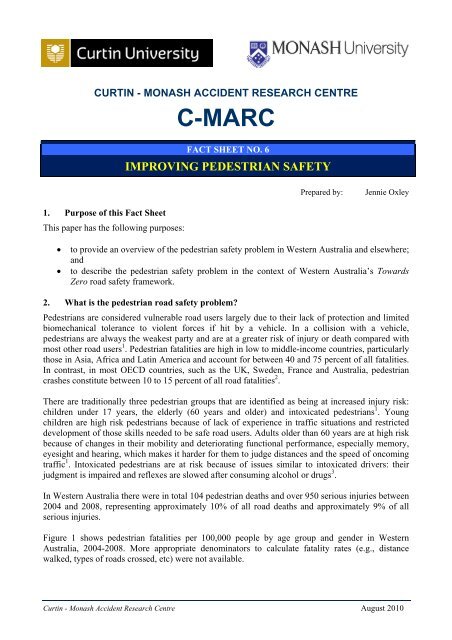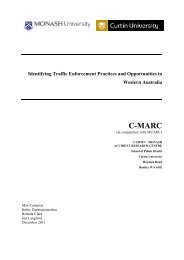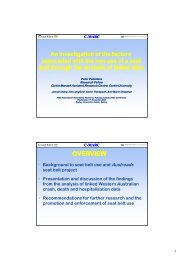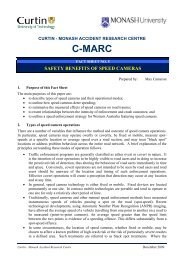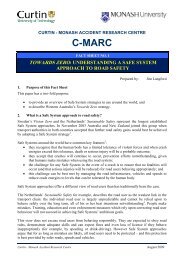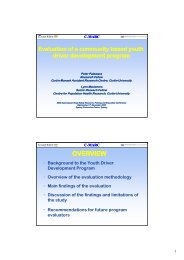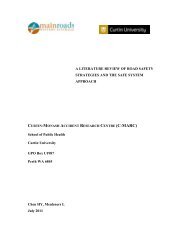Improving Pedestrian Safety - C-MARC: Curtin Monash Accident ...
Improving Pedestrian Safety - C-MARC: Curtin Monash Accident ...
Improving Pedestrian Safety - C-MARC: Curtin Monash Accident ...
You also want an ePaper? Increase the reach of your titles
YUMPU automatically turns print PDFs into web optimized ePapers that Google loves.
CURTIN - MONASH ACCIDENT RESEARCH CENTRE<br />
C-<strong>MARC</strong><br />
FACT SHEET NO. 6<br />
IMPROVING PEDESTRIAN SAFETY<br />
Prepared by:<br />
Jennie Oxley<br />
1. Purpose of this Fact Sheet<br />
This paper has the following purposes:<br />
<br />
<br />
to provide an overview of the pedestrian safety problem in Western Australia and elsewhere;<br />
and<br />
to describe the pedestrian safety problem in the context of Western Australia’s Towards<br />
Zero road safety framework.<br />
2. What is the pedestrian road safety problem?<br />
<strong>Pedestrian</strong>s are considered vulnerable road users largely due to their lack of protection and limited<br />
biomechanical tolerance to violent forces if hit by a vehicle. In a collision with a vehicle,<br />
pedestrians are always the weakest party and are at a greater risk of injury or death compared with<br />
most other road users 1 . <strong>Pedestrian</strong> fatalities are high in low to middle-income countries, particularly<br />
those in Asia, Africa and Latin America and account for between 40 and 75 percent of all fatalities.<br />
In contrast, in most OECD countries, such as the UK, Sweden, France and Australia, pedestrian<br />
crashes constitute between 10 to 15 percent of all road fatalities 2 .<br />
There are traditionally three pedestrian groups that are identified as being at increased injury risk:<br />
children under 17 years, the elderly (60 years and older) and intoxicated pedestrians 1 . Young<br />
children are high risk pedestrians because of lack of experience in traffic situations and restricted<br />
development of those skills needed to be safe road users. Adults older than 60 years are at high risk<br />
because of changes in their mobility and deteriorating functional performance, especially memory,<br />
eyesight and hearing, which makes it harder for them to judge distances and the speed of oncoming<br />
traffic 1 . Intoxicated pedestrians are at risk because of issues similar to intoxicated drivers: their<br />
judgment is impaired and reflexes are slowed after consuming alcohol or drugs 3 .<br />
In Western Australia there were in total 104 pedestrian deaths and over 950 serious injuries between<br />
2004 and 2008, representing approximately 10% of all road deaths and approximately 9% of all<br />
serious injuries.<br />
Figure 1 shows pedestrian fatalities per 100,000 people by age group and gender in Western<br />
Australia, 2004-2008. More appropriate denominators to calculate fatality rates (e.g., distance<br />
walked, types of roads crossed, etc) were not available.<br />
<strong>Curtin</strong> - <strong>Monash</strong> <strong>Accident</strong> Research Centre August 2010
Fact Sheet No.6<br />
<strong>Improving</strong> <strong>Pedestrian</strong> <strong>Safety</strong><br />
3.50<br />
Rate per 100,000 population<br />
3.00<br />
2.50<br />
2.00<br />
1.50<br />
1.00<br />
Male<br />
Female<br />
0.50<br />
0.00<br />
0 to 16 17 to 25 26 to 39 40 to 59 60 to 69 70 plus<br />
Age Group<br />
Figure 1: Rate of pedestrian fatalities per 100,000 population by age group<br />
Western Australia, 2004-2008 (Source: Office of Road <strong>Safety</strong>, Western Australia)<br />
Figure 2 shows that while older pedestrians have the highest fatality rates, young children and<br />
younger adults also have high per-population serious injury rates in Western Australia.<br />
18<br />
16<br />
14<br />
Rate of SI per 100,000 population<br />
12<br />
10<br />
8<br />
6<br />
4<br />
2<br />
0<br />
0 to 16 17 to 25 26 to 39 40 to 59 60 to 69 70 plus<br />
Age Group<br />
Figure 2: Rate of pedestrian serious injuries per 100,000 population by age group,<br />
Western Australia, 2004-2008 (Source: Office of Road <strong>Safety</strong>, Western Australia) 7<br />
3. <strong>Pedestrian</strong> safety and the Towards Zero framework<br />
The Safe Systems approach to road safety emphasises safe drivers in safe vehicles travelling on safe<br />
roads at safe speeds. This basic premise aims to eliminate fatal crashes and reduce serious injury<br />
crashes through the provision of a safe, crashworthy system that is forgiving of human error and<br />
accommodates vulnerability to serious injury 1 .<br />
Safe System principles underpin Western Australia’s road safety strategy Towards Zero. This<br />
strategy aims to reduce the number of people killed or seriously injured on WA roads by 40%<br />
between 2008 and 2020. It is intended that this will be achieved by employing evidence-based<br />
initiatives under the four Safe Systems cornerstones 4 :<br />
safe road use (20% reduction in all deaths and serious injuries);<br />
safe roads and roadsides (25% reduction);<br />
safe speeds (29% reduction); and<br />
safe vehicles (26% reduction).<br />
<strong>Curtin</strong> - <strong>Monash</strong> <strong>Accident</strong> Research Centre Page 2
Fact Sheet No.6<br />
<strong>Improving</strong> <strong>Pedestrian</strong> <strong>Safety</strong><br />
4. Safe road use for pedestrians<br />
It is reported that pedestrian behaviour is a significant cause of their injuries and fatalities 5 . A<br />
nationwide study of coroners’ reports into pedestrian deaths attributed responsibility for their road<br />
crashes fully to the pedestrian in 76% of cases and attributed partial responsibility in an additional<br />
12% of cases 6 . In other cases, dominant attitudes by drivers, failure to acknowledge the rights of<br />
pedestrians and fast speeds of drivers in areas of high pedestrian activity greatly increased the<br />
potential for crashes and, more importantly, the injury consequences once a collision occurred 7,8 .<br />
There is some evidence that the perception that vehicles have higher status on the road compared<br />
with pedestrians and the consequent behaviour of drivers may also contribute to pedestrian<br />
crashes 7,8,9 .<br />
Given that unsafe pedestrian behaviour often increases their crash risk, educational measures that<br />
aim to correct or modify these behaviours have been developed. Proponents of training and<br />
education initiatives argue that pedestrians can reduce their exposure to risk by identifying agerelated<br />
functional declines, developing appropriate behaviours to compensate for these limitations<br />
and updating knowledge of road regulations 10,11,12 . It is also considered important to educate both<br />
pedestrians and drivers to the rights and responsibilities of all road users. While there are various<br />
education and training programs, particularly for children and older adult pedestrians (e.g., ‘Safe<br />
Routes to School’, ‘Walking School Bus’, ‘Walk-With-Care’), these programs are rarely evaluated<br />
for road safety benefits. Notwithstanding, education and training programs are components of the<br />
Safe System approach and should be encouraged as a support for engineering-based initiatives,<br />
subject to on-going evaluation of their effectiveness.<br />
5. Safe roads and roadsides for pedestrians<br />
The safety of pedestrians is compromised to a large extent by the design and operation of the roadtransport<br />
system which is generally intended for vehicles and, for the most part, seems to be<br />
unforgiving of vulnerable road users. Accordingly high pedestrian injury rates are found in urban<br />
environments with high traffic flow, high speed limits, and greater population densities 13,14 .<br />
In Australia, pedestrian crashes are usually an urban phenomenon, with most collisions occurring<br />
on urban 50 or 60 km/h zoned roads 1 . Child pedestrian crashes usually occur in local streets, close<br />
to home and while the child is unsupervised, often on the way to or from school and especially<br />
while playing after school. <strong>Pedestrian</strong> crashes involving older adults also occur in built-up areas,<br />
close to home and shops, generally on a regular shopping trip, and in complex environments such as<br />
strip shopping centres, intersections and two-way roads carrying heavy and fast traffic. Intoxicated<br />
pedestrians are generally struck at night, close to drinking venues and on multi-lane roads 1 .<br />
Much of the literature has stressed the importance of separating pedestrians from motorised traffic.<br />
This is usually addressed through the use of footpaths, barrier fencing and pedestrian crossings 1 .<br />
While pedestrian crossings are generally considered a safety feature, possible improvements<br />
include:<br />
appropriate location;<br />
longer and less confusing walk and clearance phases;<br />
puffin crossings (where intelligent pedestrian detection is used to automatically extend the<br />
pedestrian’s crossing time where required);<br />
leading pedestrian interval phase;<br />
provision of auditory signals;<br />
raised crosswalks; and<br />
improvements to approaches (kerb extensions, ramps, tactile paving).<br />
<strong>Curtin</strong> - <strong>Monash</strong> <strong>Accident</strong> Research Centre Page 3
Fact Sheet No.6<br />
<strong>Improving</strong> <strong>Pedestrian</strong> <strong>Safety</strong><br />
6. Safe speeds for pedestrians<br />
Speed has a great impact on pedestrian safety and there have been many calls for moderating<br />
vehicle speeds in areas with high pedestrian activity. The faster drivers travel, the more likely they<br />
are to be involved in a crash and to severely injure vulnerable and other road users. Higher driving<br />
speeds reduce predictability and also reduce a driver’s ability to control the vehicle, including<br />
avoiding other road users. Higher speed also increases the distance a vehicle travels while the driver<br />
reacts to a potential collision, reducing the time available to avoid a collision 1 .<br />
The severity of injuries arising from a crash increases exponentially with vehicle speed – to a power<br />
of four for fatalities, three for serious injuries and two for casualties 19 . Even small increases in<br />
speed can result in a dramatic increase in the impact forces experienced by crash victims. It is<br />
estimated that for every 1 km/h increase in mean speed, the number of injury crashes will rise by<br />
around 3% (thus an increase of 10 km/h would result in a 30% increase in injury crashes) 15 . At<br />
collision speeds above 35 km/h, the probability that a pedestrian will be fatally injured rises rapidly,<br />
with death almost certain at impact speeds of around 55 km/h or higher, as shown in Figure 3.<br />
100<br />
90<br />
80<br />
70<br />
Risk of Death (%)<br />
60<br />
50<br />
40<br />
30<br />
20<br />
10<br />
0<br />
0 10 20 30 40 50 60 70<br />
Impact Speed (km/h)<br />
Figure 3: Risk of pedestrian death as a function of vehicle impact speed 16<br />
Moderation of vehicle speeds especially to speeds not exceeding 30 or 40 km/h is critical. This can<br />
be achieved through adoption of low urban speed limits (maximum 50km/h) with lower speeds (30-<br />
40km/h) in residential and shopping areas and in school zones. Additional measures to increase<br />
speed limit compliance and adoption of appropriate travel speeds include out-of-vehicle Intelligent<br />
Transport System (ITS) applications (e.g., dynamic messaging in the form of active speed warning<br />
signs and variable message signs) and introduction of traffic calming measures (e.g., pavement<br />
narrowing, refuge islands, alterations to the road surface, speed humps, roundabouts and gateway<br />
treatments). In ‘best-practice’ designs, these physical modifications to the roadway are part of an<br />
overall design concept giving vulnerable road users greater priority and discouraging high speed<br />
through-traffic.<br />
7. Safe vehicles for pedestrian safety<br />
Current design of vehicle frontal structures and vehicle mass of both passenger cars and other larger<br />
vehicles contribute significantly to the severity of pedestrian injuries. <strong>Pedestrian</strong>s struck by a car or<br />
four-wheel-drive vehicle with high bumpers and more blunt frontal profiles are more likely to incur<br />
serious head, thoracic, abdominal and spinal injuries than when struck by a passenger car with a<br />
conventional bonnet design. In contrast, a pedestrian struck by a passenger car which is more<br />
<strong>Curtin</strong> - <strong>Monash</strong> <strong>Accident</strong> Research Centre Page 4
Fact Sheet No.6<br />
<strong>Improving</strong> <strong>Pedestrian</strong> <strong>Safety</strong><br />
aerodynamically streamlined and has lower bumpers than heavier vehicles, is much more likely to<br />
incur a leg injury 17,18,19 .<br />
In previous years, there has been no mechanism for determining a car’s performance in a pedestrian<br />
collision. However the Australian New Car Assessment Program (ANCAP) has recently been<br />
extended to include a pedestrian test. The pedestrian impact test estimates injuries to pedestrians<br />
struck by a vehicle travelling at 40km/h. It consists of dummy components projected at the vehicle’s<br />
front and bonnet to evaluate head, upper leg and knee injury risk. To simplify the crash test results,<br />
ANCAP assigned a pedestrian protection rating based on an overall score, which is portrayed as a<br />
star rating out of 4 – the more stars the better 20 . It is intended that this process will have a positive<br />
impact on safer vehicle choices for both drivers and pedestrians.<br />
8. Summary and conclusions<br />
<strong>Pedestrian</strong> safety has long posed a major challenge to road safety authorities. However means to<br />
improve the safety of pedestrians include 1,9,10 :<br />
constructing traffic calming to protect pedestrians;<br />
providing additional shared paths;<br />
reducing speed limits in areas of high pedestrian activity such as strip shopping precincts;<br />
educating the community on the rights and responsibilities of all road users;<br />
including shared paths and upgraded pedestrian facilities in major infrastructure projects;<br />
nominating pedestrian and cycling infrastructure for upgrades through the Black Spot<br />
program; and<br />
promoting the manufacture and purchase of more pedestrian-friendly vehicles.<br />
Western Australia’s Towards Zero road safety strategy 4 has set an ambitious target of reducing the<br />
number of deaths and serious injuries by up to 11,000 by 2020. The measures to be adopted to<br />
reduce pedestrian deaths and serious injuries include:<br />
improved roads and roadsides, including separation, lighting and path definition for<br />
pedestrians, particularly around Indigenous communities, traffic calming in areas of high<br />
pedestrian activity, increased amount of shared paths for pedestrians and cyclists;<br />
a review of speed limits in general, and reduction of speed limits in areas of high pedestrian<br />
activity; and<br />
support for national approaches to promote the use of safer vehicles, and<br />
identification/evaluation of emerging technologies in crash avoidance and protection for<br />
occupants and people outside the vehicle.<br />
9. References<br />
1.<br />
2.<br />
3.<br />
4.<br />
5.<br />
Devlin, A., Oxley, J., Corben, B., Logan, D. (in press). Toward Zero <strong>Pedestrian</strong> Trauma. MUARC<br />
report series.<br />
World Health Organization (2009). Global Status Report on Road <strong>Safety</strong>: Time for Action. Geneva:<br />
World Health Organization. (www.who.int/violence_injury_prevention/road_safety_status/2009).<br />
WA Office of Road <strong>Safety</strong> (2009). Topics in road safety, pedestrian website. (www.ors.wa.gov.au).<br />
Transport Research Centre (2008). Towards Zero: Ambitious Road <strong>Safety</strong> Targets and the Safe<br />
System Approach. Australia: Transport Research Centre.<br />
Spainhour, L., Wootton, I., Sobanjo, J., & Brady, P. (2006). Causative Factors and Trends in Florida<br />
<strong>Pedestrian</strong> Crashes. Transportation Research Record: Journal of the Transportation Research Board,<br />
1982(-1), 90-98.<br />
<strong>Curtin</strong> - <strong>Monash</strong> <strong>Accident</strong> Research Centre Page 5
Fact Sheet No.6<br />
<strong>Improving</strong> <strong>Pedestrian</strong> <strong>Safety</strong><br />
6.<br />
WA Office of Road <strong>Safety</strong> (2007). Fact sheet pedestrians 2007. (www.ors.wa.gov.au).<br />
7.<br />
Preusser, D., Wells, J., & Weinstein, H. (2002). <strong>Pedestrian</strong> crashes in Washington DC and Baltimore.<br />
<strong>Accident</strong> Analysis and Prevention, 34, 703-710.<br />
8.<br />
Summala, H., Pasanen, E., Räsänen, M., & Sievänen, J. (1996). Bicycle accidents and drivers’ visual<br />
search at left and right turns. <strong>Accident</strong> Analysis and Prevention, 28(2), 147-153.<br />
9.<br />
Hydén, C., Nilsson, A., & Risser, R. (1998). WALCYNG - How to enhance WALking and CycliNG<br />
instead of shorter car trips and to make these modes safer. Final Report: Department of Traffic<br />
Planning and Engineering, University of Lund, Sweden & FACTUM Chaloupka, Praschl & Risser<br />
OHG, Vienna, Austria.<br />
10. Dewar, R. (1995). Intersection Design for Older Driver and <strong>Pedestrian</strong> <strong>Safety</strong>. Paper presented at the<br />
Institute of Transportation Engineers 65 th Annual Meeting, Denver, USA.<br />
11. Hagenzeiker, M. (1996). Some aspects of the safety of elderly pedestrians and cyclists, D-96-4.<br />
Leideschendam, the Netherlands: SWOV Institute for Road <strong>Safety</strong> Research.<br />
12. Zegeer, C., Stewart, J., Huang, H., & Lagerwey, P. (2001). <strong>Safety</strong> effects of marked versus unmarked<br />
crosswalks at uncontrolled locations: Analysis of pedestrian crashes in 30 cities. Transportation<br />
Research Record, 1773, 56-68.<br />
13. LaScala, E., Gerber, D., & Gruenewald, P. (2000). Demographic and environmental correlates of<br />
pedestrian injury collisions: A spatial analysis. <strong>Accident</strong> Analysis & Prevention, 32(5), 651-658.<br />
14. Zhu, M., Cummings, P., Chu, H., & Xiang, H. (2008). Urban and rural variation in walking patterns<br />
and pedestrian crashes. Injury Prevention, 14(6), 377-380.<br />
15. Nilsson, G. (1984). Speed, accident rates and personal injury consequences for different road types<br />
(No. 227). Linkoping: SNRTRI.<br />
16. Anderson, R., McLean, A., Farmer, M., Lee, B., & Brooks, C. (1997). Vehicle travel speeds and the<br />
incidence of fatal pedestrian crashes. <strong>Accident</strong> Analysis and Prevention, 29(5), 667-674.<br />
17. Ballesteros, M., Dischinger, P., & Langenberg, P. (2004). <strong>Pedestrian</strong> injuries and vehicle type in<br />
Maryland. <strong>Accident</strong> Analysis & Prevention, 36(1), 73-81.<br />
18. Lefler, D., & Gabler, H. (2004). The fatality and injury risk of light truck impacts with pedestrians in<br />
the United States. <strong>Accident</strong> Analysis & Prevention, 36(2), 295-304.<br />
19. Maki, T., Kajzer, J., Mizuno, K., & Sekine, Y. (2003a). Comparative analysis of vehicle-bicyclist and<br />
vehicle-pedestrian accidents in Japan. <strong>Accident</strong> Analysis and Prevention, 35(6), 927-940.<br />
20. ANCAP (2008). Annual <strong>Safety</strong> Review 2008 Crash Testing for <strong>Safety</strong>: Australian New Car<br />
Assessment Program. (www.ancap.com.au).<br />
Acknowledgement<br />
This fact sheet has been produced with funding from the Road <strong>Safety</strong> Council in the interest of<br />
saving lives on our roads.<br />
C-<strong>MARC</strong><br />
<strong>Curtin</strong> - <strong>Monash</strong> <strong>Accident</strong> Research Centre<br />
School of Public Health, Faculty of Health Sciences, <strong>Curtin</strong> University<br />
GPO Box U1987, PERTH 6845, Western Australia<br />
Ph: (08) 9266 2304<br />
See www.c-marc.curtin.edu.au for more information<br />
<strong>Curtin</strong> - <strong>Monash</strong> <strong>Accident</strong> Research Centre Page 6


